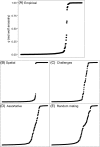Describing a developing hybrid zone between red wolves and coyotes in eastern North Carolina, USA
- PMID: 27330555
- PMCID: PMC4908465
- DOI: 10.1111/eva.12388
Describing a developing hybrid zone between red wolves and coyotes in eastern North Carolina, USA
Abstract
When hybridizing species come into contact, understanding the processes that regulate their interactions can help predict the future outcome of the system. This is especially relevant in conservation situations where human activities can influence hybridization dynamics. We investigated a developing hybrid zone between red wolves and coyotes in North Carolina, USA to elucidate patterns of hybridization in a system heavily managed for preservation of the red wolf genome. Using noninvasive genetic sampling of scat, we surveyed a 2880 km(2) region adjacent to the Red Wolf Experimental Population Area (RWEPA). We combined microsatellite genotypes collected from this survey with those from companion studies conducted both within and outside the RWEPA to describe the gradient of red wolf ancestry. A total of 311 individuals were genotyped at 17 loci and red wolf ancestry decreased along an east-west gradient across the RWEPA. No red wolves were found outside the RWEPA, yet half of individuals found within this area were coyotes. Hybrids composed only 4% of individuals within this landscape despite co-occurrence of the two species throughout the RWEPA. The low proportion of hybrids suggests that a combination of active management and natural isolating mechanisms may be limiting intermixing within this hybrid system.
Keywords: conservation‐reliant species; endangered species; genetic cline; genetic introgression; noninvasive genetic sampling.
Figures





Similar articles
-
Genetic diversity and family groups detected in a coyote population with red wolf ancestry on Galveston Island, Texas.BMC Ecol Evol. 2022 Nov 14;22(1):134. doi: 10.1186/s12862-022-02084-9. BMC Ecol Evol. 2022. PMID: 36376792 Free PMC article.
-
Assessing the prevalence of hybridization between sympatric Canis species surrounding the red wolf (Canis rufus) recovery area in North Carolina.Mol Ecol. 2011 May;20(10):2142-56. doi: 10.1111/j.1365-294X.2011.05084.x. Epub 2011 Apr 12. Mol Ecol. 2011. PMID: 21486372
-
Spatial genetic and morphologic structure of wolves and coyotes in relation to environmental heterogeneity in a Canis hybrid zone.Mol Ecol. 2012 Dec;21(24):5934-54. doi: 10.1111/mec.12045. Epub 2012 Nov 22. Mol Ecol. 2012. PMID: 23173981
-
Red Wolf (Canis rufus) Recovery: A Review with Suggestions for Future Research.Animals (Basel). 2013 Aug 13;3(3):722-44. doi: 10.3390/ani3030722. Animals (Basel). 2013. PMID: 26479530 Free PMC article. Review.
-
Wolf population genetics in Europe: a systematic review, meta-analysis and suggestions for conservation and management.Biol Rev Camb Philos Soc. 2017 Aug;92(3):1601-1629. doi: 10.1111/brv.12298. Epub 2016 Sep 28. Biol Rev Camb Philos Soc. 2017. PMID: 27682639 Review.
Cited by
-
Genetic diversity and family groups detected in a coyote population with red wolf ancestry on Galveston Island, Texas.BMC Ecol Evol. 2022 Nov 14;22(1):134. doi: 10.1186/s12862-022-02084-9. BMC Ecol Evol. 2022. PMID: 36376792 Free PMC article.
-
Space Use and Habitat Selection by Resident and Transient Red Wolves (Canis rufus).PLoS One. 2016 Dec 21;11(12):e0167603. doi: 10.1371/journal.pone.0167603. eCollection 2016. PLoS One. 2016. PMID: 28002495 Free PMC article.
-
Range contractions of the world's large carnivores.R Soc Open Sci. 2017 Jul 12;4(7):170052. doi: 10.1098/rsos.170052. eCollection 2017 Jul. R Soc Open Sci. 2017. PMID: 28791136 Free PMC article.
-
Genetic and genomic monitoring with minimally invasive sampling methods.Evol Appl. 2018 Mar 24;11(7):1094-1119. doi: 10.1111/eva.12600. eCollection 2018 Aug. Evol Appl. 2018. PMID: 30026800 Free PMC article.
-
High genomic diversity and candidate genes under selection associated with range expansion in eastern coyote (Canis latrans) populations.Ecol Evol. 2018 Dec 4;8(24):12641-12655. doi: 10.1002/ece3.4688. eCollection 2018 Dec. Ecol Evol. 2018. PMID: 30619570 Free PMC article.
References
-
- Adams, J. R . 2006. A multi‐faceted molecular approach to red wolf. PhD dissertation, University of Idaho.
-
- Adams, J. R. , Kelly B. T., and Waits L. P. 2003. Using faecal DNA sampling and GIS to monitor hybridization between red wolves (Canis rufus) and coyotes (Canis latrans). Molecular Ecology 12:2175–2186. - PubMed
-
- Adams, J. R. , Lucash C., Schutte L., and Waits L. P. 2007. Locating hybrid individuals in the red wolf (Canis rufus) experimental population area using a spatially targeted sampling strategy and faecal DNA genotyping. Molecular Ecology 16:1823–1834. - PubMed
-
- Allendorf, F. W. , Leary R. F., Spruell P., and Wenburg J. K.. 2001. The problems with hybrids: setting conservation guidelines. Trends in Ecology and Evolution 16:613–622.
-
- Bartel, R. A. , and Rabon D. R. 2013. Re‐introduction and recovery of the red wolf in the southeastern USA In Soorae P. S., ed. Global re‐Introduction Perspectives: 2013. Further Case Studies From Around the Globe, pp. 107–115. IUCN/SSC Re‐introduction Specialist Group, Gland, Switzerland and Abu Dhabi Environment Agency, UAE.
LinkOut - more resources
Full Text Sources
Other Literature Sources

